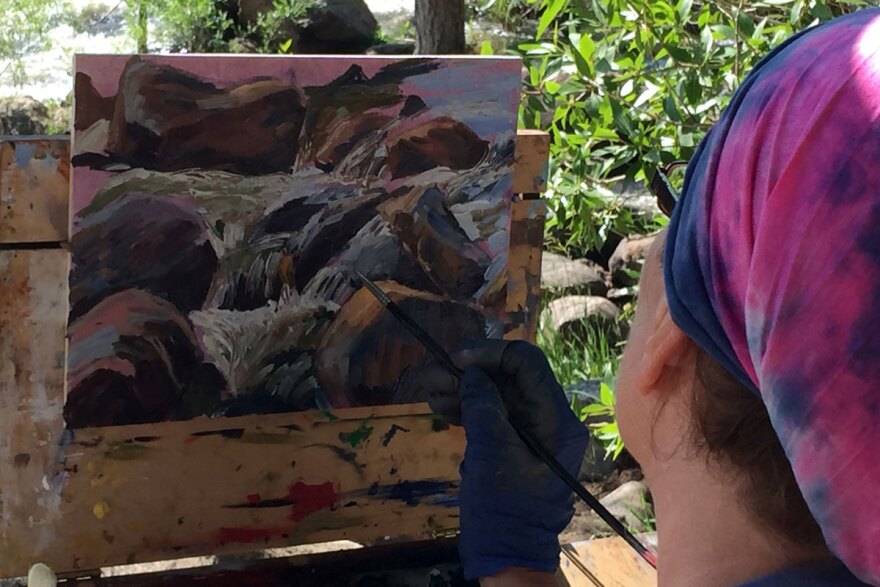For plein-air painters - that's French for "open air" - creating a work of art can be tough. Even just pronouncing it. Some say "plane air."
"The French call it 'plen air' – 'en plein air,' actually, and they are the ones who coined the term," said plein air painter Danna Hildebrand.
As a retired professor of 28 years from Sheridan College in Wyoming she would know, though she won't fault you for mispronouncing it. Pronunciation is the least of the challenges artists face when they hit the trail with their easels.
Shaded by her umbrella, Loveland artist Mary Giacomini's head tilts back and forth as her eye goes from the canvas to the rushing river in front of her.
"I just love being able to be outside like this and listening to the river, listening to the birds," said Giacomini, sitting at an easel along the Poudre River, high up the canyon. "And just kind of get lost."
Giacomini makes quick flicks of the brush, filling in defining the water flowing over the rocks in front of her.

"Two weeks ago I came out and it was sunny in the morning and I had the most beautiful shadows at 7 a.m. and they lasted for maybe a half-hour, 45 minutes, and then they were gone - completely," she said.
Time is a big challenge when your model is always on the move. Light changes. Shadows shift. At most, you've got about three hours to get a painting done - start to finish.
"It's stressful but kind of in an adrenaline way," she said. "So you just kind of want to keep going. It's a challenge. And I like a challenge."
The Trials Of Painting Plein Air
Earlier in the morning, rain kept some artists, who were meeting up for a paint out as part of the Paint the Poudre Art Show and Sale, at home. But not Giacomini. Already sitting at her easel by 6:30 a.m., she was armed and ready for whatever Mother Nature had in store. She always is.
"I've done snow, I've done rain. I've done wind. This is pretty perfect right now," she said.
When asked how exactly one paints in the snow, Giacomini said she tries no to think about how cold she is. "It's not my favorite time to paint," she admitted.
At least in the snow, there aren't any bugs to contend with.
"Mosquitos and the little files are probably the worst, and gnats, really get in the paint a lot," said Loveland painter Jennifer Cline, joking. "So you just say, 'OK, I have some birds flying in the sky...' It's a good way to prove it's plein air."
Sometimes you have to contend with something a little bigger than a mosquito.
"I was painting up at, I think at Elk Horn Ranch in Estes Park one time with a group. This pot-bellied pig came, because it's the big farm. And he was huge!" Cline said. "I didn't realize that I had an apple in the outside of my backpack that he went right for so – we had a little altercation."

While her four-legged altercation was funny, it's the two-legged ones that cause Cline more concern.
"You have to be careful if you're painting alone," she said. "You have to watch for – people, animals too, but I worry more about people than I do animals."
Which is why Cline carries bear spray and a whistle when she paints alone.
"It's people you can't normally hear because they walk so softly and they don't want to disturb you and then all of the sudden they say something and you go 'ahh!'"
It's Not Where You Are, It's Where You Need To Be
Hidden from the trail by tree branches, Greg Speer paints with one leg of his easel precariously perched on a rock at the bank of the Poudre.
"It just so happened with this particular spot, in order to see this scene, considering all the trees and everything, I needed to be right here," Speer said. "So, I had to push the envelope on the position."
Marie Massey also likes to paint on the edge.
Parked at a narrow scenic pull-off that hugs the curve of Colorado State Highway 14, Massey paints with the rushing river on one side of her and rushing cars from the highway on the other.
"The trucks keep coming by. It's pretty loud but, you know, the water drowns it out so it's pretty nice," said the Paint the Poudre organizer. "And that's just captivating there with all of that whitewater. I couldn't – I couldn't pass that up. When I see something that captivates me, then I have to paint it. I don't like to waste my time painting something that's not that interesting. And this is very interesting."
Holding on to her canvas with one hand and a paintbrush in the other, it's clear the wind is also a big challenge.
It's all part of the allure, according to Mary Giacomini.
"Like I said, I like a challenge."







